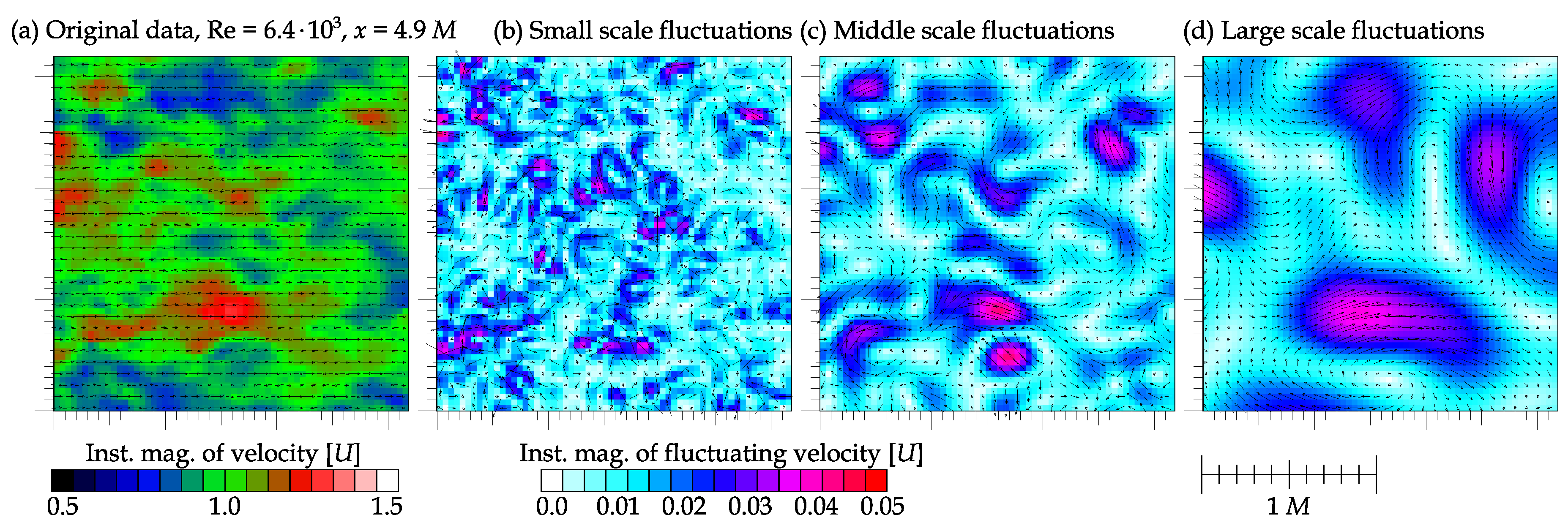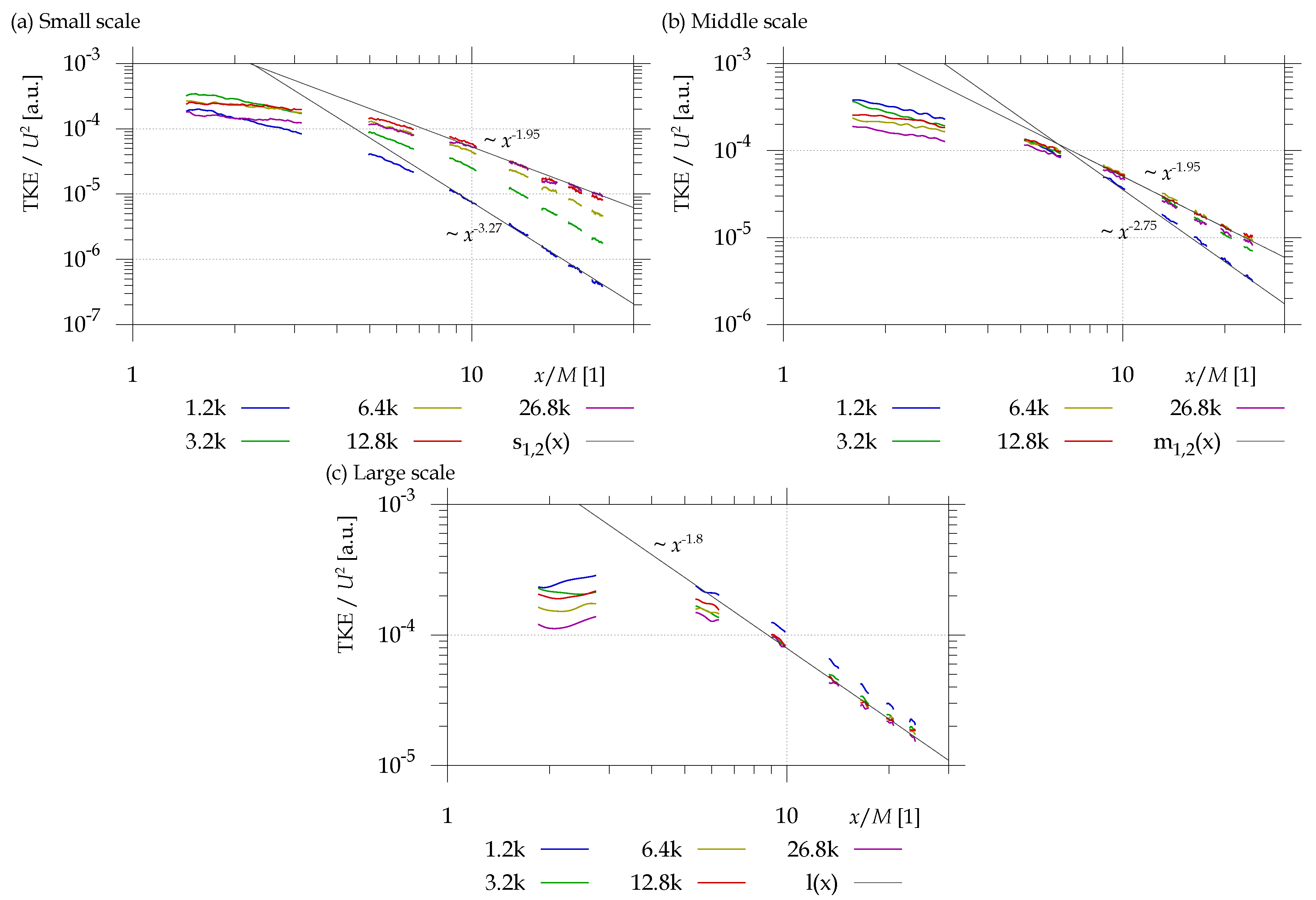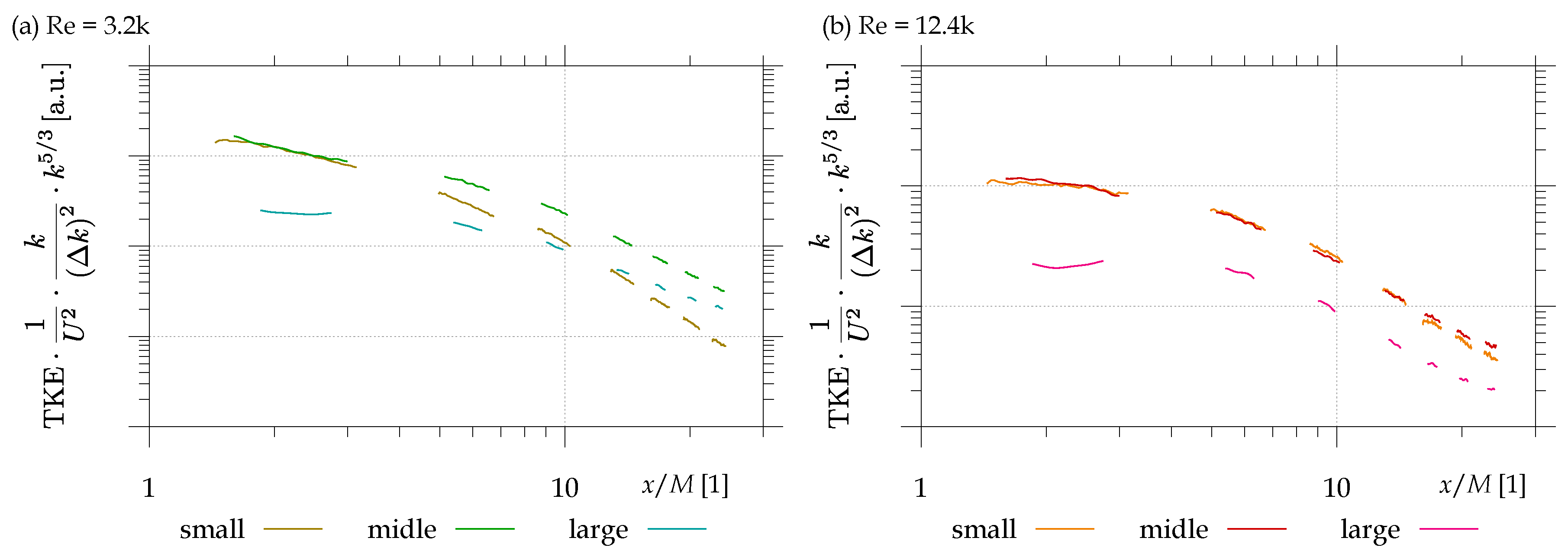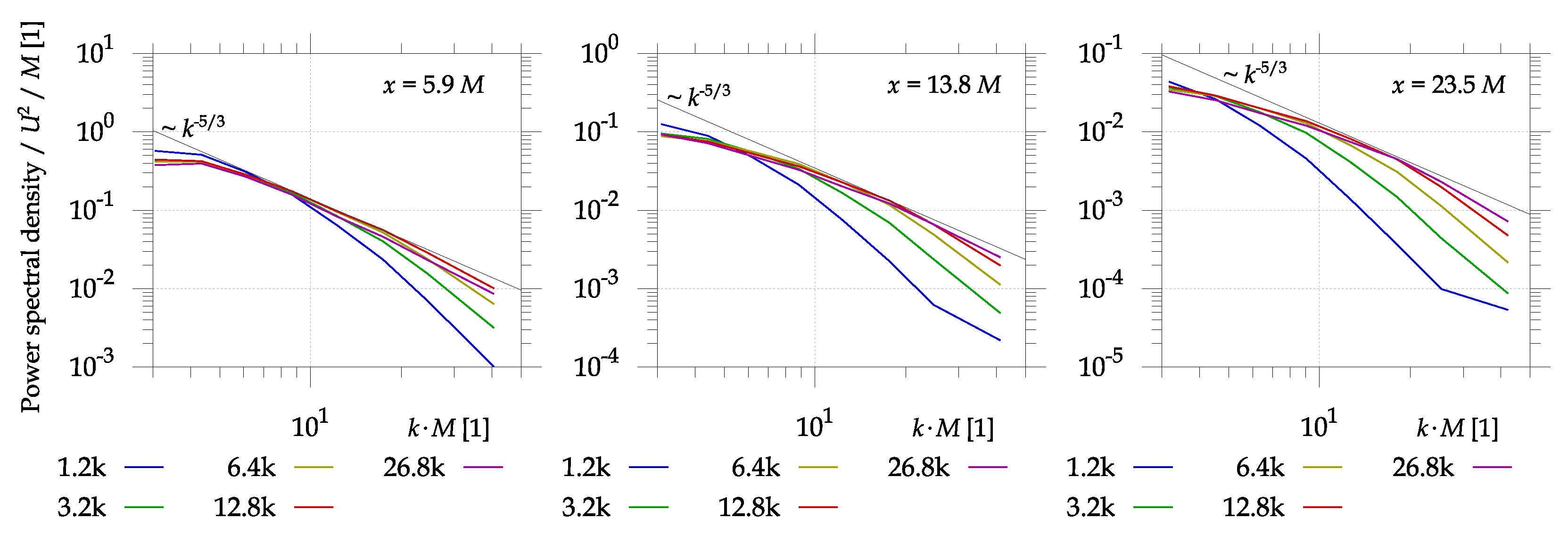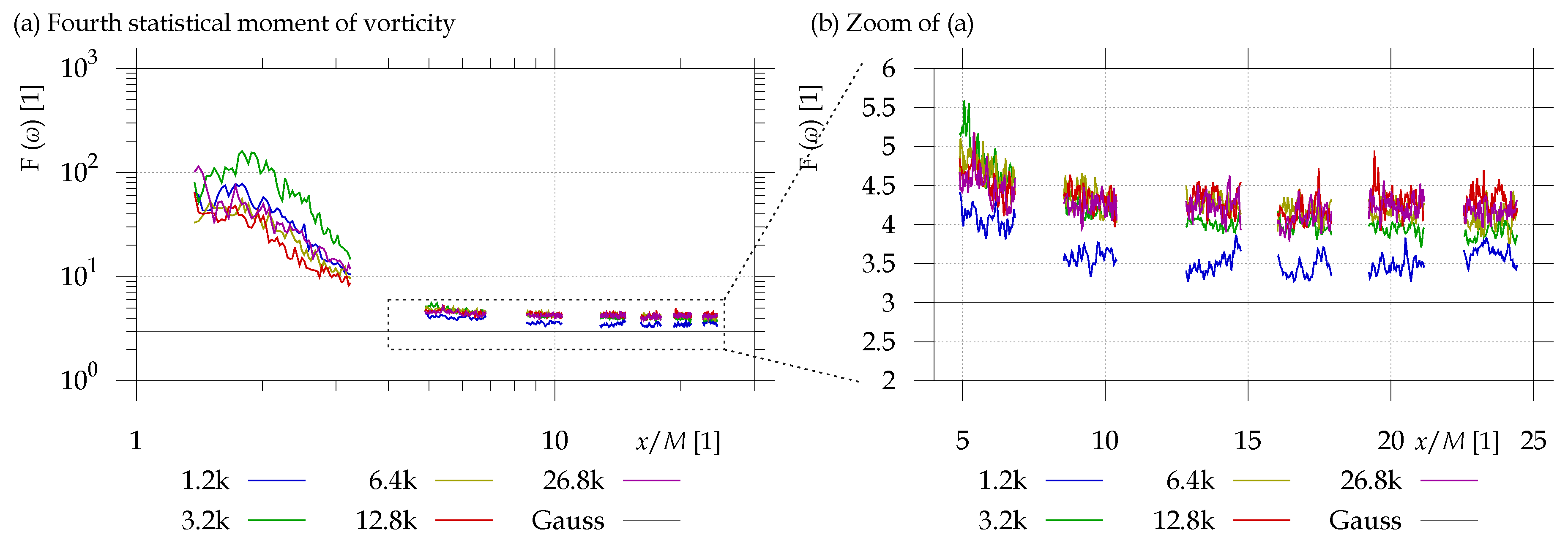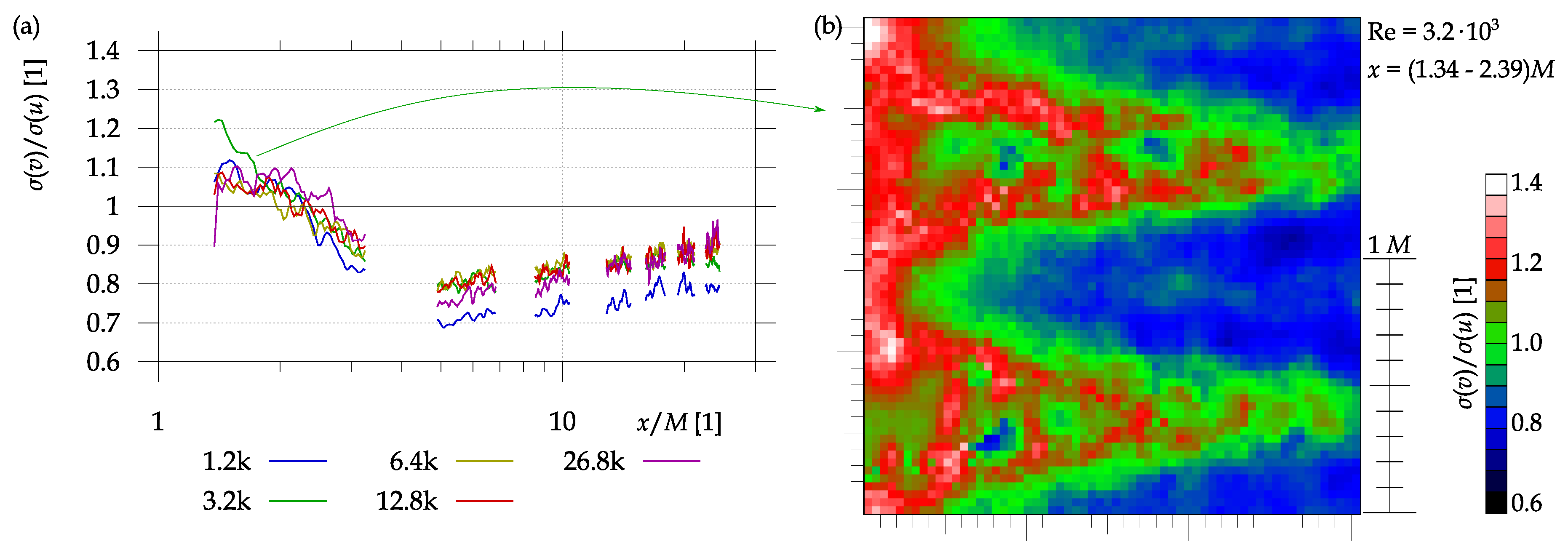The development of ensemble-averaged stream-wise velocity
u is plotted in
Figure 4. It is normalized by the average of all ensembles
U, which somehow represents the velocity in front of the grid, which is not measured as that area lies inside a metallic part of the wind tunnel without optical access. The average velocity is shown as a function of distance from the grid
x normalized by the mesh parameter
M. In the near region, the flow field is dominated by the system of wakes and jets, but the measured section cannot be a representative one, as there are not only sections like this (i.e., past the holes and rods oriented perpendicularly), but also sections past the in-plane rods. Therefore, the mass flow in the studied section is larger than the total one containing also sections past rods only. When the pattern of jets and wakes disappears, the velocity corresponds to the total mass flux. However, in later stages, another effect starts to play a role: the boundary layers of the channel slowly grow accelerating the fluid in the center of the channel in order to maintain the total mass flux.
3.1. Turbulent Kinetic Energy and Its Decay
Turbulent kinetic energy (TKE) of velocity field is calculated as the energy of fluctuating part
where
and
are the in-plane velocity components, here
u is the stream-wise component,
v is one of the span-wise components. Note that
true TKE has to be calculated by using all three velocity components, but here we use only the two measured velocity components. Angle brackets
denote averaging over time.
In in
Figure 5, the left panel shows the development of turbulent kinetic energy with distance from the grid. Note that the turbulent kinetic energy is calculated only based on the in-plane fluctuations; therefore, it is underestimated by the third component. The number in the legend is the mesh-based Reynolds number, where k plays for
. The right panel displays the same data normalized by the average stream-wise velocity
U. The function
fits the dependence in the far stages. Experimentally, we have found that the turbulent kinetic energy
e decays with distance from the grid
x as
(see black line in
Figure 5). Some authors, e.g., [
9], use a little bit more complicated function with virtual origin
; we prefer to keep the function as simple as possible not introducing too many fitting parameters, because, as John von Neumman said,
With four parameters I can fit an elephant, and with five I can make him wiggle his trunk [
10]. In any case, it converges reasonably well within the experimental noise. We can use this function
to estimate the energy dissipation rate
. The definition of the turbulent kinetic energy dissipation rate
is
by using the Taylor hypothesis of frozen turbulence, we can transform it into the
x-dependence as
Thus, inserting the function
from
Figure 5 we get
Then, by using the general estimation of the Kolmogorov scale
we can estimate the value of the Kolmogorov length
as
with experimentally obtained values of
and
. The real values of
are illustrated in the
Table 1 at the position
, where the mentioned theory starts to be applicable, and at
, where our experimental data end.
3.2. Length-Scale Dependent TKE
The effect of vicinity of the Kolmogorov scale to the turbulent kinetic energy is best apparent when we separate turbulent kinetic energy by the length-scale of fluctuations producing it. This is achieved by using the
Agrawal decomposition [
11,
12], which means the convolution of velocity
with band pass filter consisting of two Gauss functions with standard deviations
and
:
The effect of a such convolution on the velocity field is displayed in
Figure 6 for three intervals of length-scales. There is an example of length-scale dependent decomposition also referred as a Agrawal decomposition [
11,
12]. A single instantaneous snapshot at
and
is chosen for this visualization. The scale denoted
small corresponds to fluctuations of size
or
,
middle scale means
or
and the
large scale does
or
.
Inst. mag. abbreviates
instantaneous magnitude. The velocities are represented in multiples of the mean velocity
U.
The decay of length-scale dependent TKE is displayed in
Figure 7. Turbulent kinetic energies of fluctuations (TKE) of different length-scales are shown, which are visualized in
Figure 6. The energy among these scales is not normalized. Therefore,
do not compare numbers in these plots, just the shape of curves! Among different velocities, it is normalized by
. We can see that the turbulent kinetic energy decays at all scales, but at larger scale, it decays with exponent
, while the exponent
(previously found in the total TKE,
Figure 5) is valid for larger Reynolds numbers at small- and middle- scales. For smallest Reynolds number
, the decay is faster with exponent
at small scale and
at middle scale respectively. We can see, that the decay of TKE at larger Reynolds numbers follow the previously found power law. However, at smaller Reynolds number, it deviates, mainly at small scales (Panel (a) of
Figure 7) and it decays significantly faster; therefore, the scaling
does not collapse the curves. This effect repeats less strongly at middle scales (Panel (b) of
Figure 7), where only the smallest Reynolds number deviates; additionally, the power of faster decay is slightly lower than at small scale. On the other hand, the decay at largest probed scale is slower for all explored velocities. This issue can be physically interpreted as the effect of inverse processes in the Richardson cascade, which pump energy into the larger scales, where it does not originates from the beginning. This partly masks the decay at this largest scale.
To see how the length-scale dependent TKE develops, we have to normalize its values among different length-scales by the wavevector length
k and the width of the band
. Thus, as in the plots of
power spectral density we can get the energy content
associated with a wavevector
k
where
is the turbulent kinetic energy of velocity field convoluted with band pass filter of
and
(Equation (
8)),
k is the mean wavevector length
and
is the width of the wave vector interval
Additionally, we normalize the value of by the famous Kolmogorov scaling , because we consider it a priory, that the turbulence might follow this scaling. Therefore, the normalized of different length scales should collapse in the case of Kolmogorov turbulence.
Figure 8 shows such a development of TKE of different length-scales with distance from the grid. Similar to
Figure 7 this figure compares the decay of different scale TKE at two selected Reynolds numbers:
(a) and
(b). The energy is normalized by wavevector length
k and the width of the band pass filter
, additionally, it is divided by the famous Kolmogorov dependence
in order to collapse points, which follow this scaling. This attempt did not succeed; the curves do not collapse even in far regions. It is shown for two velocities only. At the beginning, there is less energy at large scale than that which would correspond to the Kolmogorov scaling, while the middle- and small- scales display intensities comparable within the noise. As the turbulence decays, the energy at all scales decreases, but the large scale TKE decays more slowly approaching the other scales. Within our range of parameters, the curves does not collapse, and thus we pose an interesting question: What happens, when they approach the normalized energy of other scales? (Would they continue decaying with the same power law, or adapt to the decay rate of the other scales?).
The small scale turbulence decays faster than the middle scale at low Reynolds number, but, at large Reynolds number, it decays in the same way as middle scale turbulence does. This relates to the vicinity of the Kolmogorov dissipative length-scale
, which has been estimated in the previous paragraph. In
Figure 9, the Spatial power spectral density of turbulent kinetic energy
at three distances from the grid:
(left),
(center) and
(right) are shown. The method of spatial spectrum from non-time-resolved data is described in our article [
8]. The
is normalized by the velocity square and grid parameter
M, wavevector length
k is normalized by
M. The solid black line represents the Kolmogorov scaling
. The spatial spectra in
Figure 9 show a similar conclusion: a clear viscosity damping effect at smaller Reynolds numbers visible as a deviation from Kolmogorov scaling depicted in
Figure 9 as a solid black line. The method of obtaining a spatial spectrum by using spatially resolved data with poor temporal resolution (note that our equipment allow a maximum sampling frequency only
) as described in detail in our article [
8] and it is based on the energies of Agrawal decompositions of different bands, as described above.
3.3. Vorticity
Vorticity is an important quantity influencing mixing at the small flow scale. Vorticity is defined as rotation of the vector field
The name of this quantity can be a little misleading in referring to vortices. However, vortices are responsible only partly for the vorticity signal [
13]. The second important source is the local shear. The third is the strain rate. Definition (
12) is not applicable for experimental data for two main reasons: first, we measure velocities only in a two dimensional section of the 3D flow, therefore, we can calculate only the
z component of vorticity; second, we measure at finite resolution. Thus, we approximate partial derivatives in the nabla operator by symmetric differentiation:
where the vector grid resolution
and
is determined by the experimental setup, not by the Kolmogorov scale, as it should be in ideal case. The measurement of full velocity gradient tensor (and thus determining full vector of vorticity) is possible with a much more complicated setup with a pair of illumination sheets used by Regunath et al. [
14].
In
Figure 10, panel (a), we show an example of instantaneous in-plane vorticity in the 7 studied areas in stream-wise × span-wise direction past the grid at mesh-based Reynolds number
. In the top row, the colorscale of vorticity is adapted to that field, while the bottom row, where the vorticity intensity changes not so rapidly, and has a common scale from
to
. Even by the naked eye we can note the smoothing of structures and (in the bottom row only) the decrease of intensity. In panel (b) of
Figure 10, there is an example of instantaneous vorticity obtained by the Stereo PIV technique in a plane perpendicular to the stream-wise direction in distance from the grid
. For esthetic purposes, these fields are smoothed by convoluting with Gauss function of
grid point. This smoothing is not applied for the plots of statistical moments of vorticity shown later.
The ensemble average of vorticity has no sense, as it results into ± zero, except in the near-grid region, it may show the shear layers between wakes and jets. More interesting is the standard deviation of vorticity:
The stream-wise dependence of
is plotted in
Figure 11 as a function of distance
. The data are normalized by using the the ratio of distance from the grid
x and average stream-wise velocity
U, i.e., a time needed to pass there (note the unit of vorticity being
, which can be seen as the time needed for turnover). This normalization to a dimensionless quantity does not work as well as for TKE, because it depends on velocity stronger than linearly. This issue can be fixed partially by multiplying by
, which is plotted in the right panel. This exponent has been found experimentally and to our knowledge it has no support in the literature. Anyway, the curves still do not collapse. We see that the data at various Reynolds numbers do not collapse. These data collapse little bit better when multiplying by
, which is displayed in
Figure 11b. In any case, this quantity is much more sensitive to noise, as it is a derivative quantity.
The flatness, i.e., the fourth statistical moment is usually used as a probe of intermittency [
15]. The flatness of Gaussian distribution is calculable analytically and it is equal to 3, which then plays a role of a reference value. High signal means that there is some level of fluctuations (described by standard deviation) disturbed by strong rare events, this behavior is typical for, e.g., neighboring shear layers. The flatness of the vorticity is calculated as
and its stream-wise development is shown in
Figure 12 as a function of distance
. The flatness of Gaussian distribution is equal to three, which is depicted by the grey line. Flatness larger than 3 signifies appearance of stronger events and large flatness is typical for intermittent effects, which can be found on the edges of shear layers, where the flow is generally quiet, but from time-to-time there comes some turbulent patch; this is the reason for large values of
in the near-grid region. In the far region,
stays between
and
with an unprovable weak dependence on Reynolds number. In the near-grid region, the flatness is large, signifying a strong intermittency effect in the pattern of jets and wakes. When we focus to the far-grid region (
Figure 12b), we see that the flatness stays between
and
, which reports the homogeneous appearance of stronger events.
3.4. Isotropy
The isotropy, i.e., the independence on the direction, can be best studied by comparing the Reynolds stress tensor components, or its invariants respectively. This can be done only for the stereo PIV data, which we have only at single
x. Elsewhere, we can compare at least the ratio of standard deviations of velocity in stream-wise and span-wise directions, [
16]. This is shown in
Figure 13 as a function of
x. Left panel (a) shows the development of the ratio of fluctuations in span-wise direction (
) to stream-wise direction (
) with distance from the grid. The right panel (b) shows one example of the spatial distribution at
and at
x from
to
, i.e., in a near grid region, where some spatial distribution related to the shear layers occurs. Green color signifies the same intensity of fluctuations in both investigated directions; red color means prevailing span-wise fluctuations, while blue color shows stronger stream-wise fluctuations. In the near-grid region we see again the effect of regular pattern of jets and wakes.
In the case of Stereo PIV we have got all three velocity components in a two-dimensional field; therefore, we can determine the full Reynolds stress tensor
. This tensor can be analyzed in the light of its invariants [
17,
18,
19].
Jovanovič [
20] claims that the anisotropy could be linked to streak patterns appearance in the flow. Those patterns are responsible for primary instability of the flow representing the first stage of turbulence development. The final stage of the fully turbulent flow tends to isotropy (the origin in the AIM graph). The streak patterns are statistically axisymmetric and correspond to a system which is invariant under rotation about the streamwise axis. The sudden appearance of small-scale random motion implies that rapid decrease in anisotropy provokes heavy growth of the dissipation which significantly reduces the smallest scale of motion defined by Kolmogorov’s length-scale. In this way, an energy cascade is initiated, which promotes the spectral separation. This is the essential feature of turbulence and determines its mixing properties. Our results confirm the published finding. The mean flow is significantly non-homogeneous close to the grid (it presents periodic features) and the inhomogeneity in the Reynolds stresses persists well downstream. The inhomogeneity observed in the Reynolds stresses at larger distances downstream of the grid is, in essence, the reminiscence of the initial nonhomogeneity of the mean flow because the turbulence production becomes ineffective at mixing the large-scale structures. Thus, any remaining non-homogeneity existing in the flow when the turbulent production becomes negligible is convected with the flow. The space-averaged data showed that turbulence generated by the grid exhibits a relatively high level of anisotropy which, as the distance behind the grid increases, tends toward one-component turbulence before quickly decreasing. Then, it is followed by a perfect axisymmetric expansion, the turbulence shows a prolate spheroid (rod-like) structure during this decay period.
Indeed, we see that in the far-grid region, there prevail fluctuations in stream-wise direction over those in span-wise one.
The anisotropy coefficient analysis is based on the Reynolds stress tensor
whose anisotropic part is normalized by its trace:
The eigenvalues of tensor
are the invariants
,
and
, which are consequently [
21] defined as
The possible values of invariants
and
are bounded by the lines depicted in
Figure 14 [
17].
Figure 14 shows the spatial average of the values of those invariant over the field of view. The anisotropy invariant map is shown in the coordinates of minus second (-II) and third (III) invariant of the Reynolds stress tensor
. These invariants can be calculated only for 3D velocity data, which are obtained by using the Streo PIV, which has been measured at a fixed distance
. The so-called Lumley triangle [
17] of mathematically accessible values is bounded by black lines. The bottom corner at coordinates
signifies full isotropy—i.e., fluctuation intensity same in all directions. In the top right corner, there would be turbulence with fluctuations in one direction only, while the left corner is associated with 2D turbulence, see [
21] for more details.
The level of isotropy is represented by another parameter
F
whose dependence on Reynolds number at the distance
is plotted in
Figure 15. The errorbars represent the standard deviation of this property within the field of view. We see that the flow is almost isotropic (
[
17,
22]) according to this parameter and an interesting behavior is that it has a maximum at finite Reynolds number
. The reason of anisotropy could be appearance of streaky structures. The character of increasing and later decreasing value of
F is unknown for us at this moment, but note that it might be an artifact of the PIV method, which is unable to resolve too small turbulent scales (and Reynolds number is closely related to the ratio of smallest to largest scale).






